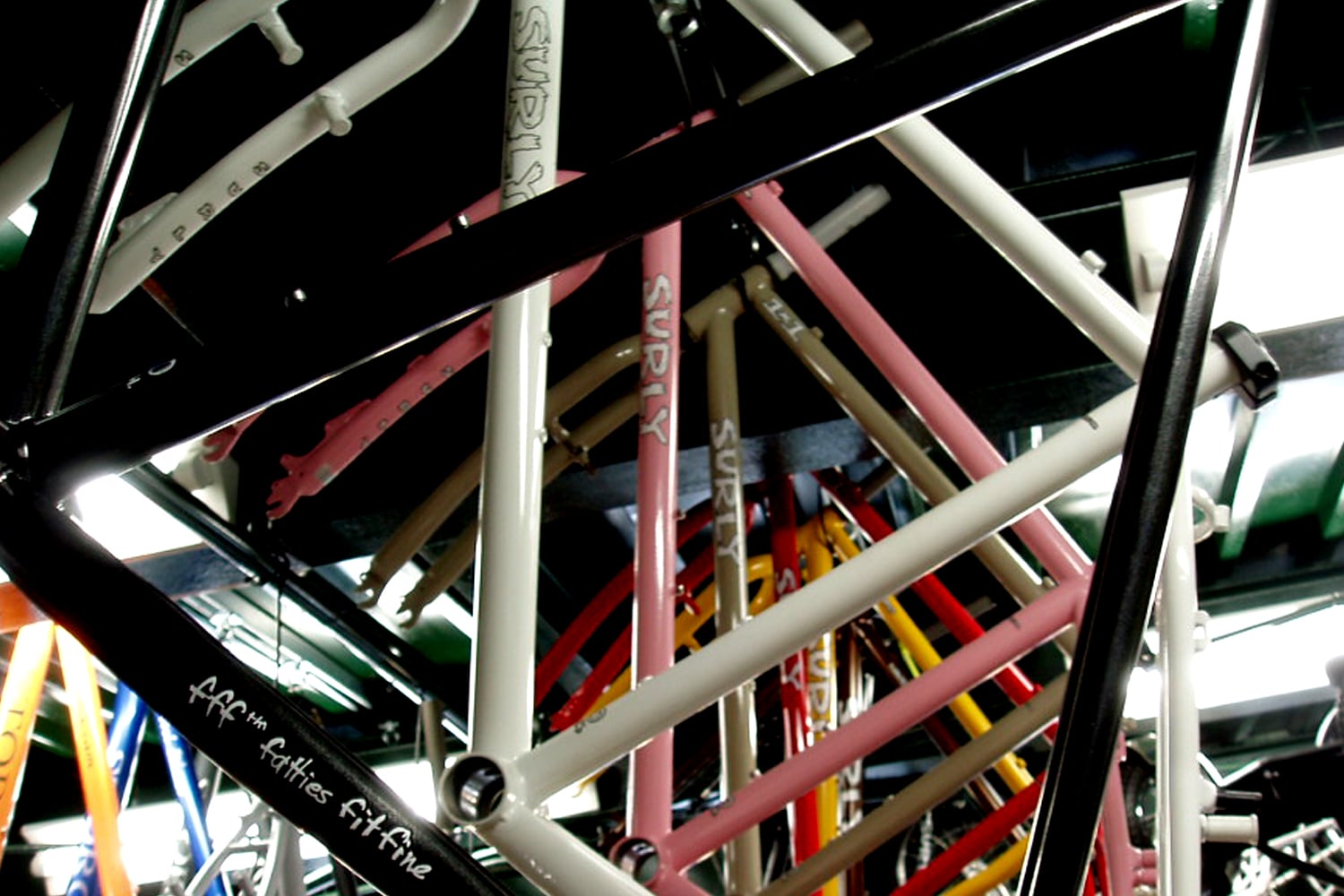We’ve experienced a strange winter here…warm and lacking snow, so it felt odd preparing for another Arrowhead 135 race…a 135-mile ultrasport race that follows the scenic and hilly DNR-controlled Arrowhead snowmobile trail from International Falls, MN to Tower, MN. Participants can run, ski, or bike the event. Like most of the racers, I choose to ride my bike each year.
Tower has seen -60F temps in winters past, but there was no chance of that during the race this year. The forecast called for above-zero-to-mid-twenties temps, snow, sleet, and freezing rain. It’s tough to prepare for a lengthy spin through northern Minnesota in those conditions. I think it’s easier to plan for consistently-cold temps. This was my 7th AH135 ride, and I’ve learned a few things over the years. But I had to rethink some of my clothing strategies to comply with the odd weather patterns.
I’ve been commuting in some new (to me) pieces from Empire Wool and Canvas Co. in Duluth, MN. This stuff is the real deal for people who enjoy playing in arctic temps for extended periods of time. I’ve been riding in the IceBike Mitts (lobster style) since early winter. And I recently started using the True North Boots on my rides to and from the office. I was confident that the boots would be plenty warm for the ride, but I wanted true mittens, not lobsters, for the AH ride…just in case the temps decided to plummet. So, Kevin Kinney, the wizard behind the Empire curtain, got me a pair of the mitten-style IceBike Mitts in time for the race.
Many of the other items were taken from last year’s clothing list. I incorporate a lot of layers into my clothing plan, so I can adjust for varying conditions. Here’s what I ended up wearing this year (inside to outside)… Torso: Ibex short sleeve base layer, Ibex long sleeve zippered pullover, Ibex hoodie, Lowe Alpine full-zip fleece jacket. Legs: Mt Borah Lycra cycling shorts, Craft winter tights, RaceFace knickers. Head: Pearl Izumi thin cap, Pearl Izumi windfront headband. Feet: Surly wool socks (Blockhead design), plastic produce bags (2 layers), Surly tall wool socks, ragg wool socks (unknown origin), Empire True North Boots. Hands: Stephenson vapor barrier gloves, Ibex wool liner gloves, OR mitten shells. I brought the Empire IceBike Mitts, and I wore them for an hour at the beginning of the race. But they were simply too warm for the conditions, so I switched over to the OR shells for the remainder of the ride. I don’t have any regrets about bringing the Empire mitts. Historically, the forecasted temps have been wrong. And I like being prepared for anything that Mother Nature might throw at us along the way.
Clothing that I carried but never used: Wool Buff, Craft balaclava, Montane Pertex smocks…XL and XXL, Sierra Designs 800-fill down vest, Cannondale mesh-back vest, Ibex short sleeve wool t-shirt
Everybody has to carry a minimum amount of supplies throughout the race. Here’s the required gear list:
• -20F degrees sleeping bag or colder rating
• Insulated sleeping pad
• Bivy sack or tent
• Firestarter (matches or lighter)
• Stove
• 8 fl. oz. fuel at ALL times (either gas, alcohol or 2 canisters of propane/butane 100 g. each or 12 Esbit tablets)
• Pot (min. volume is 1 pint)
• 2-qt (64 fl. oz.) or just under 2 litres, insulated water container
• Headlamp or flashlight
• Flashing red LED lights, both on front and back of sled or bike (or on backpack if skier). Everyone have at least 10 square inches of reflective material on front and back of the person for this race. Two lights total are required, one on the front of the bike, sled or racer (runner or skier with backpack), one on the back of the bike, sled or racer (runner or skier with backpack). Each light must have a minimum of three flashing red LEDS.
• Whistle on string around neck to call for help, because your mouth is too numb to yell.
• 1-day food ALL times (3000 calories)
I brought the following items to comply with the mandatory list.: Big Agnes -20 sleeping bag, Thermorest Ridgerest pad (short), Equinox bivy, mini Bic lighter (with child-resistant mech removed), titanium Esbit stove and Esbit fuel tabs, 1-pint titanium pot with lid and windscreen, Isotherm insulated bottles, Princeton Tec Apex Pro headlamp, Cateye 3-LED red flashers front and rear, reflective triangles front and rear, plastic whistle, and the same jar of peanut butter that I’ve carried during the race for the last 5 years. Ok…maybe it’s time to retire it and bring something with a current freshness date.
I relied on many of the same food items from previous AH rides. The list varies little from year to year. On the menu: Pringles (cheddar), Fritos, chocolate-covered raisins, smoked almonds, mixed nuts, dried cherries, Gummi bears, peanut butter cups, bacon, aged sharp cheddar cheese, Ginsting Honey Stingers, Honey Stinger waffles, Slim Jims, homemade chocolate chip dessert bars, homemade hard candy, and fruit cake…my father-in-law makes awesome liquor-soaked fruitcake that is packed with calories.
New vehicle for this year’s race: the Moonlander with Clown Shoe rims and Big Fat Larry tires. I’ve been riding the Moonlander since we received frame samples early last year, so I had no doubts about its trail worthiness. The Moonlander rocks the largest tire and rim combo available. The big unknown prior to the race: Would it be overkill?
My Moonlander is built with a 2 x 7 drivetrain (22/34t Surly stainless chainrings x 14t – 34t cassette), pre-MWOD proto crankset, Microshift thumbshifters and rear derailleur, XT direct-mount front derailleur with Problem Solvers direct-mount adapter, Titec J-bar with Dimension cork grips, DT 350 rear hub, Surly 135mm front hub, Avid mechanical rear disc brake with Dirty Dog rotor, DT 1.8/2.0 spokes, Surly Lite inner tubes, Deore brake lever, 3T stem, Cane Creek 40 headset, Odyssey Triple Trap pedals, Salsa Shaft seatpost, and WTB Pure V saddle. No real bling on this ride. This is how I ride it throughout the year…with the addition of a front Avid mechanical disc brake and the corresponding Deore lever.
As usual, Revelate Designs bags – Moonlander/Pug framebag, Gas Tank, Viscacha saddle bag, handlebar harness, and harness bag - are used to carry my gear. I’ve been torturing Revelate bags for many years on many different bikes, in a wide array of conditions. This stuff is well-designed and extremely durable.
This year, my dad, Jerry, and my 8-year-old son, Noah, accompanied me to the race. Dad has always chauffeured me and my bike to the race and supported me during the event, but this was Noah’s first trip to the nation’s icebox. It was great to have them both along for this one.
Dad pulled up at 5:30am Sunday Morning to pick us up for the 5-hour trip north. We intended to get the gear-check around 11:30am, factoring in an hour for breakfast along the way. I’d slept a few hours Sunday morning. That’s a few hours more sleep than I usually get. I’m typically sewing this – or wrenching on that – right up the point when my dad arrives.
We arrived in International Falls around 11:45. I checked my gear, which didn’t take very long (I know the routine) and chatted with some of the racers who were hanging out in the gear-check area. We checked into our room, and I packed my bike. Then we drove over to – and attended - the pre-race meeting, followed by an early dinner at a local restaurant.
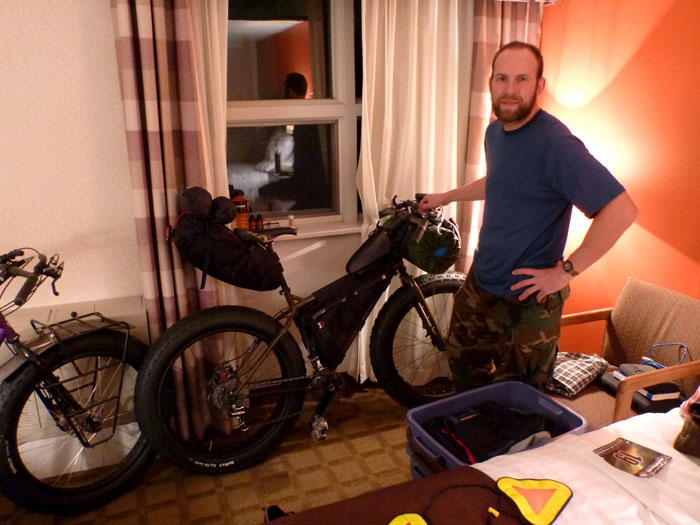
It was still early by the time we got back to the hotel, and Noah wanted to go swimming. Noah swam in the pool, turned every knob, and pushed every button on the sauna and whirlpool control panel, while my dad and I hung out in the pool area and talked with old and new friends. I come up to the Arrowhead to ride, of course. But I really enjoy the company of the likeminded souls who are there to push themselves as I do. We geek out on gear, talk about the race, and just catch up on each other’s lives. I see most of these folks once a year, but it always feels familiar.
I sat around with Chuck Lindner, one of the good-hearted veterans of the race and a kindred spirit, discussing outdoor clothing, firearms, race nutrition, bike-camping, and family until 9:30…the time to coax Noah The Fish out of the pool and get some sleep.
After a quick shower and a quick scan of my gear, I fell into a deep, dreamless sleep.
I woke up at 5:00am feeling refreshed and ready for the long ride. My dad and Noah were up, too.
My clothes had been set out the night before, my bike was packed, and my Dad was soon off to get breakfast from McDonalds. I didn’t have to be out the door until 6:35 in order to get to the starting line for the 7:00 am send-off. So, I leisurely put on half of my riding clothes…didn’t want to get too hot, filled my water bottles, coaxed Noah to get dressed and pack up his stuff, and waited for Dad to get back with those consistently-foamlike Dirty Ron’s flapjacks.
I typically don’t eat breakfast that early, but I knew that my muscles would utilize any fuel that I could cram into my system. So I forced down two of the golden discs, a cup of O.J., a bit of coffee, and some Gatorade. Then I donned the rest of my clothing, slathered some Dermatone on the unbearded portion of my face, and made a hasty retreat to the out-of-doors with my bike before I could start to sweat.
It was 8 degrees (F) outside….downright balmy for January 30th in International Falls. I was comfortable in a thin hat and a headband. Every other year required a balaclava and a facemask at this early hour. I was ready to roll, so I started pedaling toward the Kerry Arena, the check-in point and starting line, less than a mile away. Noah and my dad would soon follow in the truck.
I appreciate the opportunity to ride to the start. I can make sure the bike is dialed in, and it allows me to warm up a bit before setting out on my day-long roll through the northern Minnesota wilderness. The tires were aired up to 15 PSI, and they felt pretty good on the new snow. I knew that I’d probably let some air out after a rode a few miles of the race, but it’s much easier to ere on the high side instead of having to take out the pump to increase the pressure if it’s initially too low.
I checked in, took some photos, and approached the starting line. Dad was volunteering this year. So he and Noah took off for a road crossing, a few miles down the trail, to halt cars and/or racers if the need arose.
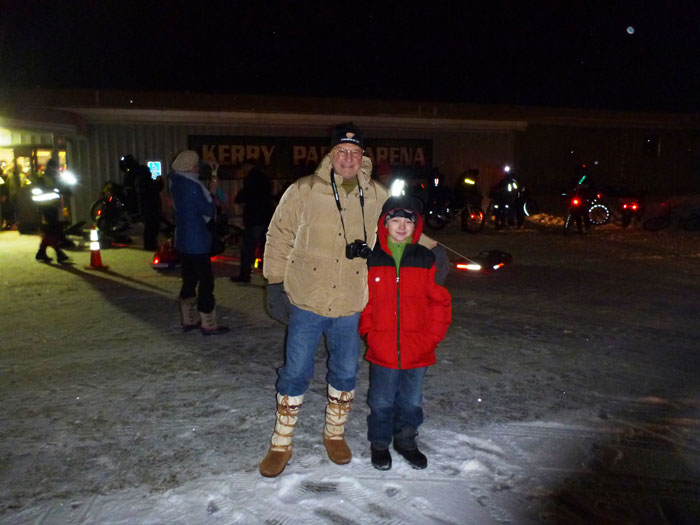
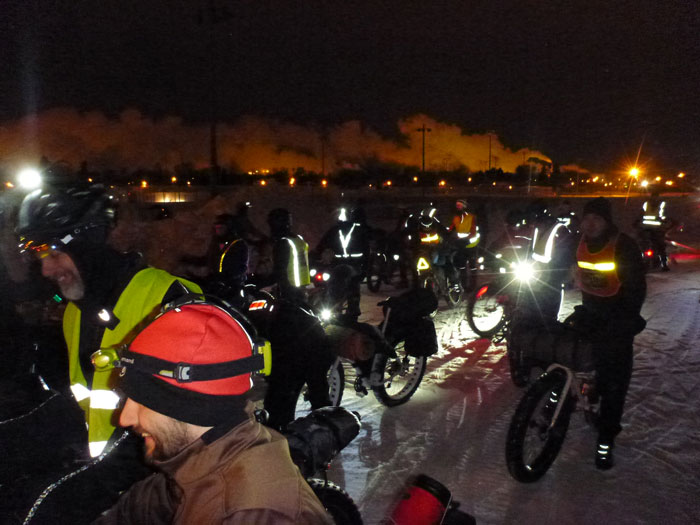
At 7:00, the bikers were let off their leashes, and we were moving southwest down the trail. Skiers go out at 7:02. Runners start at 7:04. Newbs and potential race winners go out fast. Slower, realistic veterans find their paces and settle in for the long haul. I typically fall into the latter category, knowing that I’ll sweat out my insulation and wear myself down prematurely if I try to hang with the big dogs out of the gate.
It wasn’t long before I approached and passed Dad and Noah with a wave. I was glad to see them…even if it was still very early in the race.
At the sharp turn to the east, I stopped to let a bit of air of the tires, drink some water, and suck down a Honey Stinger packet. I popped a piece of candy in my mouth, too. Orange-flavored, I think. I wasn’t ready to eat, but I knew that I had to put calories in to get energy out. I was passed by a half-dozen riders, but it didn’t matter. I’d have another 125 miles to catch them if that was meant to be.
I rode for another hour and came to the Highway 53 crossing where Noah and my dad were waiting for me. I stopped, talked for a bit, posed for some photos, drank some water, and gulped down a bottle of 5-hour energy drink. Lindsay Gauld was there. I was bummed that he hadn’t been able to start due to some very untimely food poisoning, but it’s always good to see him. Lindsay and I usually ride and rest together at one or more points during the race, and we tend to finish around the same time. Last year, he finished 30 minutes ahead of me. Lindsay is riding the 350-mile Iditarod Invitational race this year, so he still has some riding to look forward to.
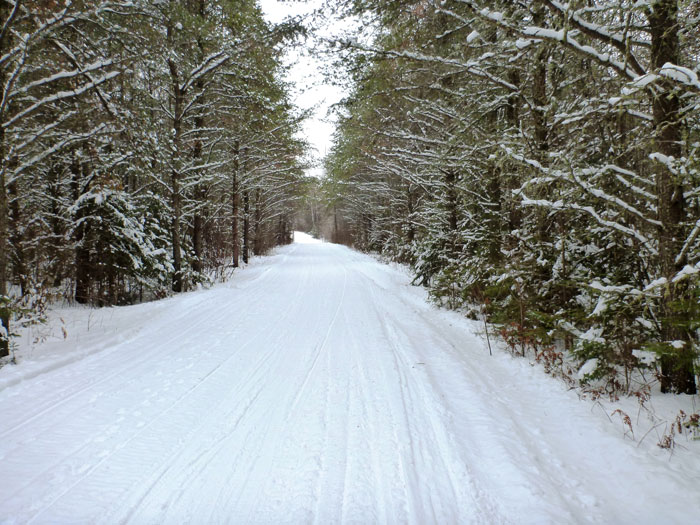
I was off again. Next stop: The Gateway Store…the first checkpoint, 18 miles further down the trail. The trail was in pretty good shape, and it was made smoother and faster by the riders who had gone before me.
I arrived at the store as Charlie Farrow, another veteran of the AH135, was rolling out. Noah and Dad were waiting for me there, of course. I went inside to fill up my water bottles, drink a bottle of Gatorade, and choke down some of the food I’d been lugging around. I still wasn’t hungry, but, at some point, eating becomes a necessity. I finished my food and drink, and I was out on the trail again at 11:06.
The trail got softer at this point. The temperature was rising and snowmobiles had erased the tracks of the riders before me. I had to bust my own trail and it started to get hilly, so my speed decreased. But it was nice to have a little change of topography and more opportunity to get out of the saddle. Finally, I saw the telltale signs of a high-energy 8-year-old in the vicinity: small footprints zigzagging across the trail. I knew Sheep Ranch Road must be close, and, sure enough, Dad and Noah were waiting for me there.
After getting the lowdown on who was where on the trail, I took off again in pursuit of Steve Yore, Bill Shand, and Charlie Farrow. I took quite a while to catch up to Steve, and then up to Bill, but I wasn’t able to reel in Charlie. He was 15 minutes ahead of me.
At 4:25, I got to Melgeorge’s Resort, the midway (mile 72) checkpoint, after crossing Elephant Lake. Dad and Noah met me as I came off the lake and joined me in the cabin while I took a break from the trail. It’s always a great relief and a pleasure to get to this point, because more than half the race is behind us (in mileage, at least) and we are treated like kings and queens there. The incredible race volunteers cook for us, dry our clothes, and otherwise make us feel as comfortable as they can. The cabin is warm, bright, dry, and full of great people. The downside: it’s very hard to leave that environment and continue on down the cold trail toward the finish line.
I literally had a bowl of soup in my hands before I had my boots off…followed by a grilled cheese sandwich, a couple cups of Coke, and another grilled cheese sandwich. In the meantime, my clothes were tumbling in the dryer, and I was able to relax a bit while Charlie and Josh Peterson (another AH race veteran) prep’d to ride again. Bill Shand came off the lake right after I did, but he only stayed in the cabin long enough to fill up with water before heading out again.
In order to not to get sucked into the black hole of comfort, I made a move to ready my food and drink for the next leg of the trail before lethargy set in. I wasn’t moving fast, but I was making forward progress toward getting out the door again. I pulled my clothes out of the dryer while they were still a bit damp, but they were much dryer than when I’d arrived at the cabin.
Josh, Charlie, Steve Yore, and Tracy Petervary were out the door and riding before I could do the same. I just wasn’t in a huge hurry to ride that last section, so I dawdled a bit. Another crew of bikers and one skier – yes, a skier - arrived while I was making my last push to get back on the trail. That skier, Casey Krueger, ended up crushing the old skiing record by 14+ hours. Finally, an hour and twenty minutes after getting to the resort, I bid farewell to everybody at the cabin and started to pedal again toward the finish line.
Almost immediately, after leaving the resort parking lot, we are treated to a long climb…a glimpse of what it is to follow for the next 40 miles. I was happy to find that the trail had firmed up a bit, and there were plenty of clear bike tracks for me to follow. In years past, I’ve cursed these hills…each and every one of them. But the trail conditions, this year, were very good in this area. The Moonlander was climbing and descending much better than it had earlier in the day, and I was enjoying the ride more than ever.
I was feeling good and making good progress through hilly sections and low, flat sections. My lights were working very well, too. After last year’s self-imposed light debacle (in short, I ran out of light with no moon to rely on), I made sure I was prepared for this year’s ride. On my bar: Princeton Tec Push with lithium batteries. On my head: Princeton Tec Apex Pro with lithium batteries. I used the Push on the climbs and flat sections, and I turned on the Apex (in addition to the Push) for the descents. This is the first year that I felt I had more than enough light for the fast descents. I’ve been using Princeton Tec lights since I won my first light at a local 24-hour race in 1998. I’m very happy with the vast majority of PT products that I’ve tried. The Push and Apex are no exceptions. I rely on the Push for illuminating my commutes, year 'round.
I rode at a quick (for me) pace, hoping I’d catch up to some of the riders who departed from the resort before me. Eventually, my effort paid off and I caught up to Tracy and then to Steve. I was still having fun on those hills.
It was sleeting and raining a bit at this point. My bags were icing up, but I was warm and comfortable. My main concern was that the trail conditions would deteriorate. That pushed me even harder. I wanted to ride as much good trail as I could before it was compromised by the weather.
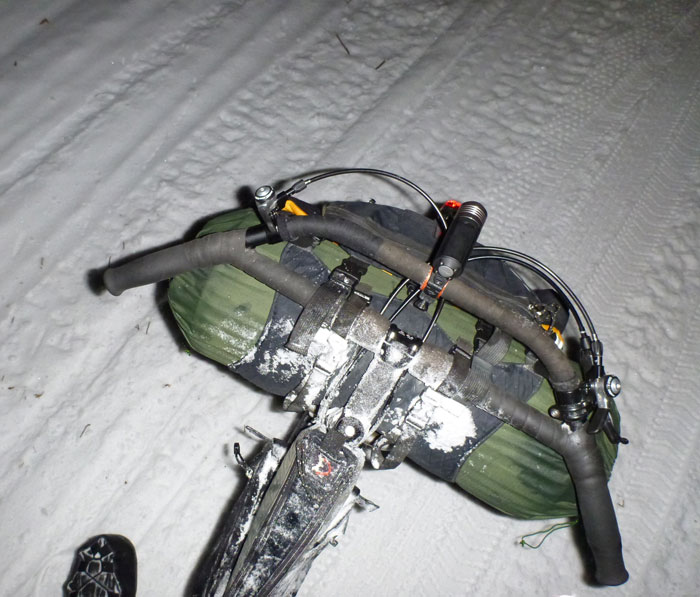

A bit later, I saw flashing red lights by one of the shelters. One of the racers had bivy'd there. A little further on, I saw another set of red flashers along the trail. Another rider was camped along the trail. He had a fire going. It was a sweet little spot, and I was tempted to stop there for a bit. But I didn’t want to risk long-term seduction of that warm fire. I kept rolling.
I reached the Ski Pulk checkpoint at 12:04am. The temperature had risen and the sleet had totally turned to freezing rain. The volunteers at this station were hanging out in a canvas teepee tent that housed a woodstove. After I filled my water bottles, I was lured into the tent by hot cocoa and the dry heat of that stove. It was heavenly. I really wanted to stay for a while, but, again, I knew that I needed to move along as to not risk becoming a victim of the strange weather. I was out again at 12:09.
I expected to meet Noah and my dad there. But when I didn’t see them, I just assumed that they’d failed to find the spot or that they’d chosen to avoid the freezing rain and, instead, gone ahead to the Fortune Bay Casino…the finish line. It turns out that they were parked up the hill from the checkpoint spot, and they were expecting a phone call when I came in. The phone call never came, and they missed me.
I had been told that Charlie hadn’t come in yet, so I knew he had been one of the sleeping bodies I’d passed along the trail. And Bill Shand was 30 minutes ahead of me. It was unlikely that I’d catch Bill in the remaining 24 miles, but it was worth a shot. I proceeded again at a decent pace, hoping to see a red blinker down the trail at some point.
2 miles after Ski Pulk, the trail flattens out and stays that way until the finish. For me, it’s the most mentally grueling part of the course. 3+ hours of riding relatively flat, straight, featureless trail…in the dark. All I could do was spin and try to think about everything but my aching muscles. Then, about 8.5 miles from the finish, I saw white lights. At first, I thought it might be a snowmobile. But the lack of noise outed it as a bike. It was Lindsay Gauld. He was out for ride to meet up with his friends from Manitoba who left Melgeorge’s after I did. Lindsay filled me in on the photo finish…a close sprint between two of the Alaskan riders, the placing of the other finishers, and the status of the other racers on the course. It turns out the Josh Peterson was the other bivy'd rider I’d passed.
Bill was still 4 miles ahead of me, according to Lindsay. I wasn’t going to catch him, but I was ready to finish my ride and get off that bike. So I bid Lindsay farewell and continued on my way.
I crossed the finish line to the cheers of the finish line crew at 3:51am….20 hours and 51 minutes after starting. Good enough for 12th place.
So…how do I summarize the race?
• The Moonlander worked perfectly in regards to shifting and braking. No mechanicals at all. The wheels might have been a bit wide for this year’s conditions, but I don’t think I would have gone much faster with a different set-up. If I’m slow, it’s because this engine needs a bit more tuning. I can’t really blame the bike.
• I brought too much food this year. I always do. But the warm temps didn’t stimulate my appetite as much as cold temps typically do, so I ate less than usual.
• My clothing worked fine. I was comfortable the whole time. But, it was a mild year. There was a larger margin for error without serious consequences. I carried a lot of clothing that I didn’t use, but I don’t regret having that safety net onboard.
• I spent less time at the checkpoints this year. I will try to further decrease that idle time next year.
• The organization by the race directors and the volunteer support was better than ever. I would like to thank all of the people who made this race a successful one. You folks rock, and we all appreciate what you do. Thank you, thank you, thank you.
My aches and pains have subsided, and I’ve made my list of things I can do differently next year. There’s always more tweaking and geeking to do, which is part of the reason I keep coming back. Chances are…I’ll be out there again next year. And I’m predicting that the weather and trail conditions will be different. They always are.
 Surly Bikes
Surly Bikes